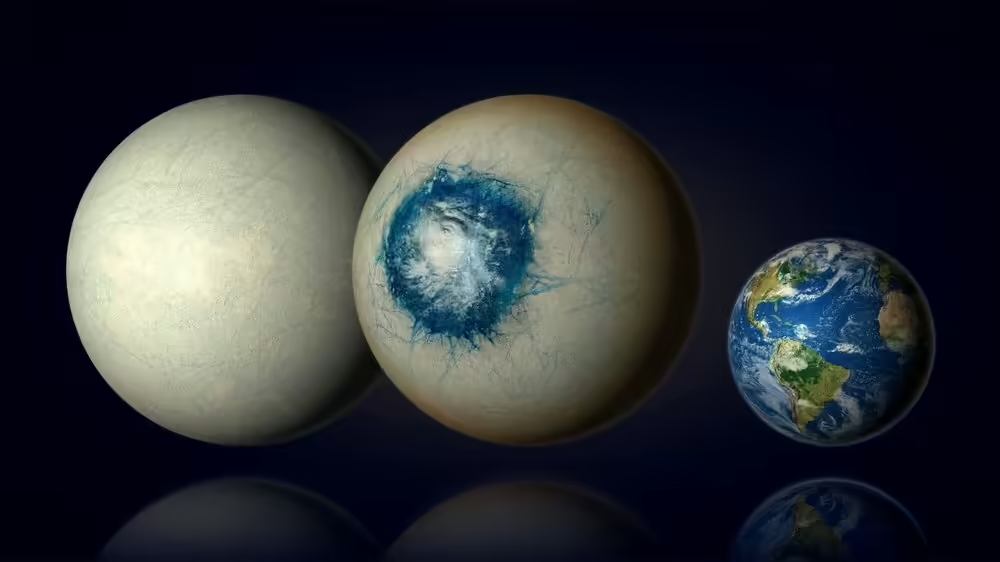Astronomers find planet with ocean closest to solar system
- July 11, 2024
- 0
The recently discovered planet LHS 1140 b has piqued scientists’ interest as a potentially habitable planet. In a new paper, Canadian researchers confirm that it is likely a
The recently discovered planet LHS 1140 b has piqued scientists’ interest as a potentially habitable planet. In a new paper, Canadian researchers confirm that it is likely a

The recently discovered planet LHS 1140 b has piqued scientists’ interest as a potentially habitable planet. In a new paper, Canadian researchers confirm that it is likely a world with a warm ocean surrounded by a nitrogen-rich atmosphere.
Today, about 5,500 exoplanets are known, with thousands more awaiting confirmation. The most attractive of these are those found in the habitable zone. This is the name of the region around the parent star where worlds with a climate similar to ours, and therefore the water necessary for the development of life, can be found.
Earth is the only known planet with seas and oceans. There are moons of planets in the solar system that hide bodies of water under the ice. Nothing similar has yet been found in other star systems, only candidates. Any indication of liquid water or water ice on an exoplanet is of great interest.
This is what happened to the planetary system of the star LHS 1140, located 48 light-years away in the Cetus constellation. Its discovery was announced in 2017. It has two planets, one of which, LHS 1140 b, is in the habitable zone.
Observations showed that this is either an ice world or peace with the ocean. The authors of the new study calculated its parameters with great accuracy – no worse than the TRAPPIST-1 system – and settled on a model. The article was published on the preprint server of Cornell University and will be published soon. Astrophysics Journal Letters.
LHS 1140 b orbits a not-so-big red dwarf, about one-fifth the size of the Sun. Observations suggest it could be a mini-Neptune or a super-Earth. The former contains mostly gaseous small planets with dense, hydrogen-rich atmospheres, while the latter contains rocky, Earth-like planets.
If LHS 1140 b belongs to the class of super-Earths, then its surface is most likely covered by a global ocean and has a shell of hydrogen gas on top. Such worlds are called Hykean planets. A powerful telescope like the James Webb could detect it with certainty. And so it happened.
At the request of scientists led by Professor René Dayon and Charles Cadeau of the Trottier Institute for Exoplanet Research of the University of Montreal (Canada), the telescope observed the transit of LHS 1140 b twice, with the help of the Canadian NIRISS instrument (Near IR) camera etc. it is a super-Earth.
According to new data obtained by the Spitzer, Hubble and TESS orbital observatories, the exoplanet LHS 1140 b is 1.7 times larger than Earth and has a mass of 5.6 times greater. There are also indications that its atmosphere is rich in nitrogen, which likely formed after the subsoil solidified and replaced the primary gas shell. This is the first time this has been observed in objects with temperate climates.
LHS 1140 b turned out to be less dense than Earth. It is 10 to 20 percent water by mass. It is either a “snowball” planet or an icy world with a liquid ocean that always occupies the region facing the star. This is possible because of the synchronous rotation of the planet and the star, similar to how we only see one side of the Moon from Earth.
According to models developed for LHS 1140 b, if the planet has an Earth-type atmosphere, it is more likely to be a “snowball” with a giant eye ocean of four thousand kilometers across, half the surface area of the Atlantic Ocean. The temperature in the water column may be comfortable – about 20 degrees Celsius.
LHS 1140 b appears to be the best biomarker candidate so far. It is only necessary to first confirm the parameters of the atmosphere and determine its model. This will require new observations from James Webb during transits and eclipses, with an emphasis on looking for signs of carbon dioxide. This will allow us to understand the composition of the atmosphere, including whether greenhouse gases that create conditions suitable for life are present on the surface. Given that the telescope can only observe the planet eight times a year, it will take several years to clarify all these questions.
Source: Port Altele
As an experienced journalist and author, Mary has been reporting on the latest news and trends for over 5 years. With a passion for uncovering the stories behind the headlines, Mary has earned a reputation as a trusted voice in the world of journalism. Her writing style is insightful, engaging and thought-provoking, as she takes a deep dive into the most pressing issues of our time.